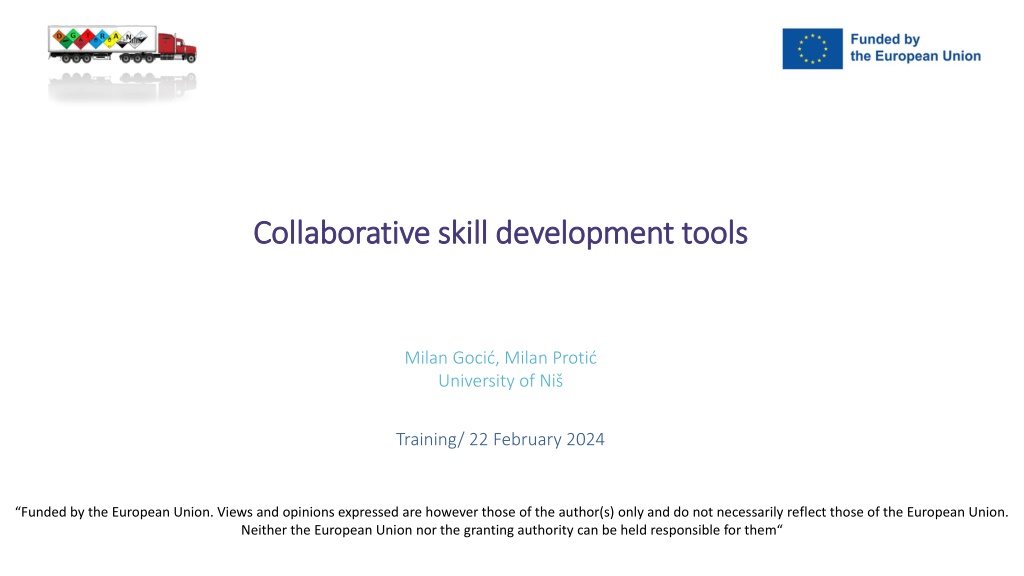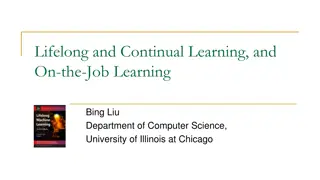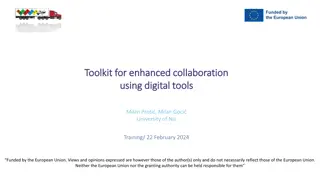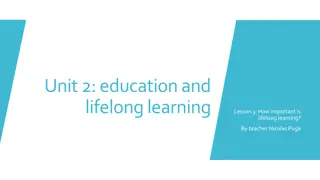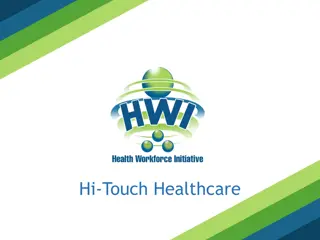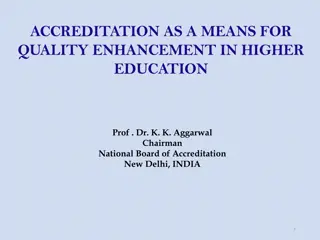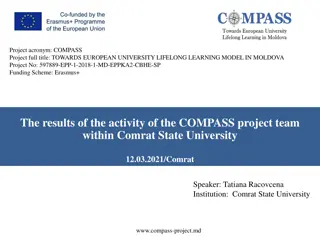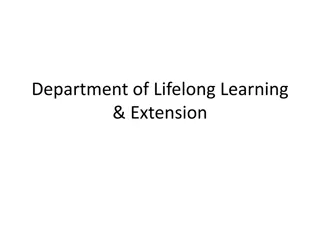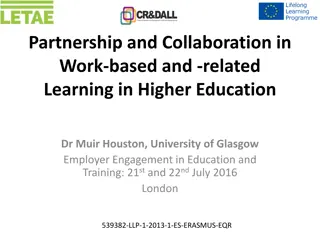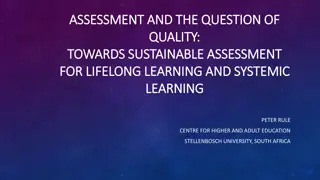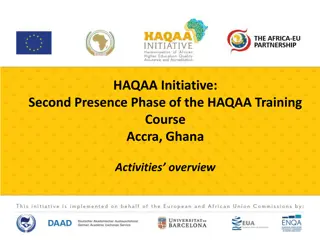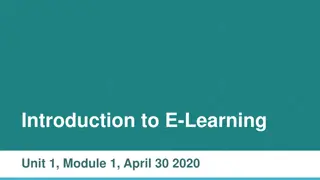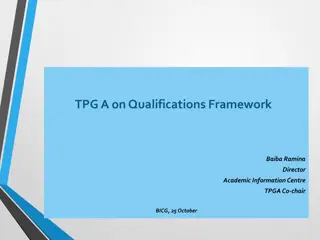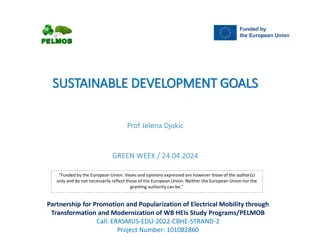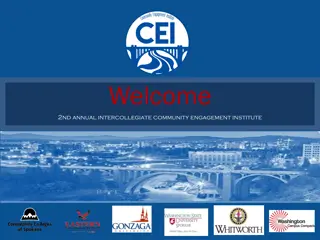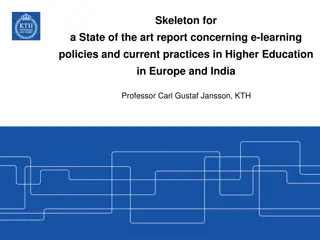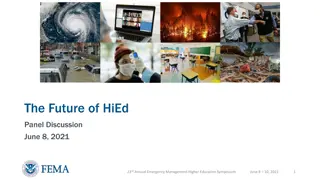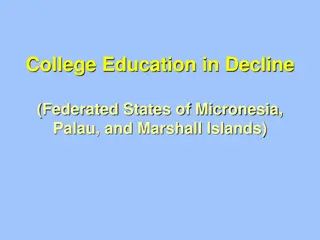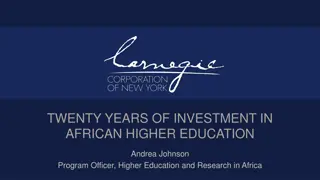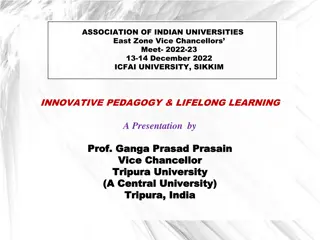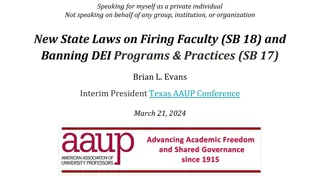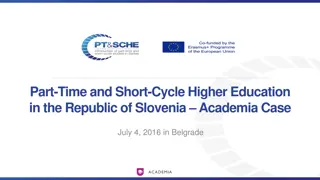Enhancing Collaboration in Higher Education and Lifelong Learning Programs
The augmented collaboration toolkit, developed under the SMARTEN project, aims to support trainers and teachers in higher education and Lifelong Learning programs. It includes digital tools like Miro, GroupMap, and Howspace, along with collaborative skill development tools such as InterVision methodology, Deep Democracy, and Culture Mapping Tool. Key elements in creating an augmented collaborative workplace involve proper design, facilitation, and feedback. Facilitators play a crucial role in creating a safe environment for participants to share ideas and drive discussions towards common objectives. Tips for a productive collaborative workplace include starting meetings with a check-in, providing agendas beforehand, delegating tasks for engagement, and asking engaging questions.
Uploaded on Oct 03, 2024 | 0 Views
Download Presentation

Please find below an Image/Link to download the presentation.
The content on the website is provided AS IS for your information and personal use only. It may not be sold, licensed, or shared on other websites without obtaining consent from the author. Download presentation by click this link. If you encounter any issues during the download, it is possible that the publisher has removed the file from their server.
E N D
Presentation Transcript
Collaborative Collaborative skill skill development development tools tools Milan Goci , Milan Proti University of Ni Training/ 22 February 2024 Funded by the European Union. Views and opinions expressed are however those of the author(s) only and do not necessarily reflect those of the European Union. Neither the European Union nor the granting authority can be held responsible for them
Introduction The augmented collaboration toolkit is being developed to support trainers and teachers within higher education and LLL programs, as a support for serious games to create a shared narrative, and for the skills to work in digital environments. It has been jointly designed through the academia and Lifelong Learning programs. The toolkit, developed under the SMARTEN project (www.smartenproject.eu), is composed of two components: - Digital tools for the augmented toolkit are Miro, GroupMap and Howspace. - Collaborative skill development tools are InterVision (peer-coaching) methodology, Deep Democracy (Lewis) and Culture Mapping Tool (Erin Meyer). Transport of Dangerous Goods - Modernization of Curricula and Development of Trainings for Professionals in the Western Balkans HEIs /DGTRANS www.smartwb.ucg.ac.me
Digital collaboration process Three elements are key in creating this an augmented collaborative workplace: proper design, facilitation, and feedback. Design should emphasize the research question related to the training or workshop and highlight the objectives while considering the needs and expectations of participants. Facilitation is a supportive process that aims to bring all members to share their ideas, questions, and perspectives to identify a common objective then work together to make it happen. Feedback represents a key reflection on the participant s experience within the collaborative tools and examines the learning outcome. Transport of Dangerous Goods - Modernization of Curricula and Development of Trainings for Professionals in the Western Balkans HEIs /DGTRANS www.smartwb.ucg.ac.me
Facilitator A facilitator identifies what the purpose of the event is and designs a setup that matches this purpose. The role of facilitator can be summarized as: o Create and enable safe environment for participants to share and discuss their ideas. o Encourage the conversation by asking questions and keeping the discussion going. o Drive the discussion into reaching a decision or the specific objective by harvesting the best ideas. o Stay impartial and don t pose ideas. Transport of Dangerous Goods - Modernization of Curricula and Development of Trainings for Professionals in the Western Balkans HEIs /DGTRANS www.smartwb.ucg.ac.me
Tips to create a productive collaborative workplace Always start the meeting with a check in, so attendees can get to know each other and bring their attention. Provide the agenda beforehand then try to go through it in a form of questions during the meeting. Delegate some of your tasks to attendees for further engagement and accountability. Keep asking questions such as: o What do you think? o What would you do? o Do you have any other ideas? Wrap up with a quick debrief and plan follow-ups. Curricula innovation in climate-smart urban development based on green and energy efficiency with the non-academic sector Transport of Dangerous Goods - Modernization of Curricula and Development of Trainings for Professionals in the Western Balkans HEIs /DGTRANS www.smartwb.ucg.ac.me
The collaborative skill development tools Collaboration skills are key to foster teamwork in any workplace and enable problem-solving through working on soft skills such as communication and interpersonal skills. Developing these skills has many advantages mainly for students including: - Development of higher-level thinking, oral communication, self- management, and leadership skills. Promotion of interaction between students themselves and with trainers. Increase in student retention, self-esteem, and responsibility. Exposure to several perspectives. - - - Transport of Dangerous Goods - Modernization of Curricula and Development of Trainings for Professionals in the Western Balkans HEIs /DGTRANS www.smartwb.ucg.ac.me
InterVision (peer-coaching) methodology InterVision is a structured consultation of a small group of equal professionals. During InterVision meetings, certain issues about personal functioning within the work context are discussed. The purpose of peer review is to maintain professional expertise and to boost the professional's personal functioning. During the meetings, the participants learn from the case histories, but above all to listen, ask good questions and reflect. Transport of Dangerous Goods - Modernization of Curricula and Development of Trainings for Professionals in the Western Balkans HEIs /DGTRANS www.smartwb.ucg.ac.me
InterVision (peer-coaching) methodology 1. Ideally, the group consists of about 6 participants. 2. InterVision is regularly held 1 time every 6 or 8 weeks. 3. A (fixed) location will be arranged. 4. A process supervisor is appointed for each meeting (this can be external, but after practice also internal). 5. We work according to a structured method. Transport of Dangerous Goods - Modernization of Curricula and Development of Trainings for Professionals in the Western Balkans HEIs /DGTRANS www.smartwb.ucg.ac.me
Iceberg model McClelland's Iceberg Model is a useful tool that teaches participants about the level at which they ask questions. Only the top of the iceberg above the water level is visible. This part represents the visible behavior that has a certain effect on the immediate environment. However, most of the iceberg is underwater and consists of thinking, feeling, wanting and our blueprint. A blueprint is understood to mean experiences that have had such an impact in our lives that the effect still works in the present. For example, culture, upbringing, and important life events. Transport of Dangerous Goods - Modernization of Curricula and Development of Trainings for Professionals in the Western Balkans HEIs /DGTRANS www.smartwb.ucg.ac.me
Iceberg model The influence of the different levels goes from the bottom of the iceberg to the top, but also the other way around. For example, a successful project can lead to a person thinking positively about themselves, increasing self-confidence and making it easier to take on the next challenge. By asking questions at the different levels, insight is gained into the perspective from which the case introducer looks at the situation and as a result some solutions may not come into view. By offering other perspectives, other solutions also come into the picture. When the group is trained in asking good questions and understanding the issue, they can switch to the abbreviated variant. Curricula innovation in climate-smart urban development based on green and energy efficiency with the non-academic sector Transport of Dangerous Goods - Modernization of Curricula and Development of Trainings for Professionals in the Western Balkans HEIs /DGTRANS www.smartwb.ucg.ac.me
10-step method Curricula innovation in climate-smart urban development based on green and energy efficiency with the non-academic sector Transport of Dangerous Goods - Modernization of Curricula and Development of Trainings for Professionals in the Western Balkans HEIs /DGTRANS www.smartwb.ucg.ac.me
5-step method Curricula innovation in climate-smart urban development based on green and energy efficiency with the non-academic sector Transport of Dangerous Goods - Modernization of Curricula and Development of Trainings for Professionals in the Western Balkans HEIs /DGTRANS www.smartwb.ucg.ac.me
Theme-based method Curricula innovation in climate-smart urban development based on green and energy efficiency with the non-academic sector Transport of Dangerous Goods - Modernization of Curricula and Development of Trainings for Professionals in the Western Balkans HEIs /DGTRANS www.smartwb.ucg.ac.me
Deep Democracy (Lewis) Deep Democracy (DD) is a set of simple yet powerful tools and skills, developed in South Africa by clinical psychologists Myrna and Greg Lewis, based on Arnold Mindell s process-oriented psychology. It is a cutting-edge facilitation and conflict transformation methodology that is pragmatic, easily acquired and can be used by people with no psychology training. Its contribution comes from providing a new way of seeing situations and the necessary skills to: - Improve and accelerate decision making - Gain real commitment and engagement - Resolve conflict - Enhance productivity and performance Curricula innovation in climate-smart urban development based on green and energy efficiency with the non-academic sector Transport of Dangerous Goods - Modernization of Curricula and Development of Trainings for Professionals in the Western Balkans HEIs /DGTRANS www.smartwb.ucg.ac.me
Integrating the voice of minority To be able to tackle a polarity, we have to map it out. Why do we have such a trouble to be more inclusive, to deal with citizens' participating, to connect with other/ related sectors, to change our way of working? Reflecting and talking are important, but so is taking action! What will be the focus after the break? Which topic do we need to discuss? Curricula innovation in climate-smart urban development based on green and energy efficiency with the non-academic sector Transport of Dangerous Goods - Modernization of Curricula and Development of Trainings for Professionals in the Western Balkans HEIs /DGTRANS www.smartwb.ucg.ac.me
Lewis Deep Democracy method This method has four steps: - Collect all views of all attendees - Actively look for alternatives trying to emphasize the differences in views - Spread the alternative by working on compromising - Add the minority wisdom to the majority vote by working on creating the necessary synergies. Transport of Dangerous Goods - Modernization of Curricula and Development of Trainings for Professionals in the Western Balkans HEIs /DGTRANS www.smartwb.ucg.ac.me
The Culture Mapping Tool Confucius said In their nature all people are the same, it is their habits which makes the difference . Culture influences many aspects of our life including daily lifestyle, thinking, communication style and perception. Thus, cultural mapping is key because it provides an integrated picture of the cultural character, significance, and workings of a place to help people recognize, celebrate, and support cultural diversity for economic, social, and educational development. Curricula innovation in climate-smart urban development based on green and energy efficiency with the non-academic sector Transport of Dangerous Goods - Modernization of Curricula and Development of Trainings for Professionals in the Western Balkans HEIs /DGTRANS www.smartwb.ucg.ac.me
Inter-Cultural Perception Model The model shows that culture is a combination of four pillars: basic set conventions, norms, habits & rules. Conventions are agreements about how to behave in specific situations . They are related to interpretations of behavior . Scripts are a sequence of events which takes place along the line of implicit and explicit conventions. They coordinate social actions in case of differences in or misunderstanding about scripts cooperation becomes difficult. Curricula innovation in climate-smart urban development based on green and energy efficiency with the non-academic sector Transport of Dangerous Goods - Modernization of Curricula and Development of Trainings for Professionals in the Western Balkans HEIs /DGTRANS www.smartwb.ucg.ac.me
Inter-Cultural Perception Model Characteristics of Conventions & Scripts: - Pertain to behaviour - Situation specific - Vary across nations, regions, groups - Have an obligatory character o Infringement is noticed o Infringement results in surprise embarrassment, sanctions . Curricula innovation in climate-smart urban development based on green and energy efficiency with the non-academic sector Transport of Dangerous Goods - Modernization of Curricula and Development of Trainings for Professionals in the Western Balkans HEIs /DGTRANS www.smartwb.ucg.ac.me
Culture Map Erin Meyer The Culture Map was created by Erin Meyer, an American author and professor at INSEAD Business School, based in Paris. It provides a new way forward, with vital insights for working effectively and sensitively with one s counterparts in the new global marketplace. This tool shows that cultures fall on the eight culture map scales which compare how each builds trust, gives feedback, and makes decisions. Erin Meyer, Professor at INSEAD Transport of Dangerous Goods - Modernization of Curricula and Development of Trainings for Professionals in the Western Balkans HEIs /DGTRANS www.smartwb.ucg.ac.me
Eight scales of the culture map Transport of Dangerous Goods - Modernization of Curricula and Development of Trainings for Professionals in the Western Balkans HEIs /DGTRANS www.smartwb.ucg.ac.me
Dealing with the cultural differences Communication *Make clear rules everyone agrees upon and knows why you explicitly agree upon them *Put in writing *Check: Listen, Summarize, Dig Deeper/Deep Questions/ Discus *Indicate your own boundaries and communicate when necessary *Adapt but never take over behaviour *Private is always the safe choice *Change between how and why/ practical vs theoretical *Accept slower decision-making process *Be aware of difference and discuss them Evaluating Persuading Leading *Management by objectives, concrete and specific *Set goals individual and team level Transport of Dangerous Goods - Modernization of Curricula and Development of Trainings for Professionals in the Western Balkans HEIs /DGTRANS www.smartwb.ucg.ac.me
Dealing with the cultural differences Deciding Trusting *Make and agree upon an explicit decision-making model *Time for relation building pays off everywhere *Show your through self the relationship is the collaboration *Choose a common communication tool *Maybe you don t have to be in all meetings as leader? *Depersonalize ideas *Introduce you will disagree *Agree specifically on time perception/ planning system to use Disagreeing Scheduling Curricula innovation in climate-smart urban development based on green and energy efficiency with the non-academic sector Transport of Dangerous Goods - Modernization of Curricula and Development of Trainings for Professionals in the Western Balkans HEIs /DGTRANS www.smartwb.ucg.ac.me
How to start inter-cultural teamwork? 1. Map your own/ your teams perception on the scale 2. Use the Country Mapping Tool 3. Reflect on outcome: a) Do you agree with the positions as outlined on the maps? Why or Why not? b) What else can you share with the group to better understands each others positions. c) Which and how can these concepts impact the team s collaboration? d) What can we do to be more effective, given the differences? 4. Make a Team Collaboration Plan with clear framework Transport of Dangerous Goods - Modernization of Curricula and Development of Trainings for Professionals in the Western Balkans HEIs /DGTRANS Curricula innovation in climate-smart urban development based on green and energy efficiency with the non-academic sector www.smartwb.ucg.ac.me
